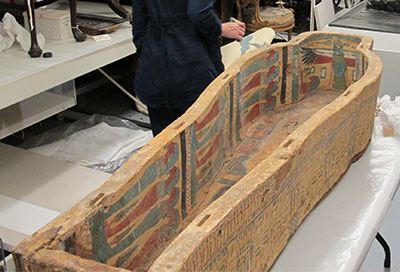by William Sweet
The Mead’s mummy is missing.
Truth be told, the 2,600-year-old mummy case has likely been empty for the entire half-century that it’s been with the Mead Art Museum. But records show that it once contained a preserved human body. This leaves museum staff with a mystery worth unraveling even as they prepare an ancient artifact for exhibit.
As with any good mystery, the more one learns about the Mead’s mummy case, the more questions arise.
Amherst College acquired the case, with a mummy, in 1905, decades before the Mead came into being. Along with the case came the lid for a different mummy case. There appear to be no records indicating where these items were kept or where the mummy went. No records, just stories.
“When I first started working here in 2000, I was told that Amherst College did at one time possess a mummy and it was stolen,” said Stephen S. Fisher, the Mead’s collections manager. As to the date and the circumstances of the theft, he has no clue. “All I know is that it has never been found,” he said.
Staff at the Mead have been investigating this issue as they start a project which they hope will allow the mummy case and lid to be brought out of storage and displayed for the public.
“The coffin is an interesting object because it has a story to tell, and because the craftsmanship is of good quality,” said Bettina Jungen, senior curator and Thomas P. Whitney Class of 1937 Curator of Russian Art. She noted that Amherst is unique among the Five Colleges in having such an object.

Conservator Erin Toomey examines the mummy case lid
Erin Toomey, an objects conservator with the Brooklyn-based Art Conservation Group, recently visited the Mead’s storage facility to examine the case and lid. She plans to compile a report for the museum on what its options may be to restore, conserve and otherwise prepare the objects for exhibit. Jungen said that the museum would need to raise funds for any restorative work.
Joyce Haynes, a Egyptologist formerly with Boston’s Museum of Fine Arts, has been approached to take a look at the hieroglyphics on the case.
While the mummy case is unusual, it is not the only mortuary piece at the Mead. The museum recently put on display a second-century Roman sarcophagus, which originally held the remains of two young children, a brother and sister ages 6 and 10, possibly the victims of a plague that swept the Roman Empire. For the exhibit, poet Richard Wilbur ’42, the John Woodruff Simpson Lecturer at Amherst, translated the marble sarcophagus’s inscription, which refers to the children being preceded in death by their father, leaving a widow and mother whose “eyes shall nevermore be dry.”
While the mummy case is not as display-ready as the Roman piece, “the paintings on the side are in incredible shape,” Toomey said, and the wood beneath the paint and gesso is relatively solid for its age.
“Pieces are falling off, but a lot can be done to stabilize it and get it into shape,” she added.
The fact that the artifacts do not seem to have generated much interest in years past may have helped preserve the pieces, as some past practices aimed at restoring ancient artifacts can compromise them, Toomey said. “A lot of times what happens is a piece like this will be restored and all painted in and varnished, all the missing parts filled in, and it almost becomes like a decorative object, and we wouldn’t want it to look like a decorative object.”
What exactly was done with the mummy, the case and the lid during their first 50 years at the college—and even where these items were stored throughout that time—remains unknown.
According to information on the undated accession card at the Mead, the case is for a woman embalmed in Abydos about 650 B.C., and the lid is for the coffin of a priest interred during the same era, Egypt’s 26th Dynasty. Both artifacts are decorated with hieroglyphics, including some in praise of Osiris, the Egyptian god of the afterlife.
The artifacts were donated to the college in 1905 by Dr. Stephen Holmes Weeks (1835–1909), dean of the medical school at Bowdoin College, sometime after Weeks had been awarded an honorary law doctorate at Amherst’s 1905 Commencement. The Amherst trustees endorsed a resolution in June 1906 to extend their thanks to Weeks “for the valuable gift of a mummy lately presented by him to the College.” A June 1906 article in The Student mentions a mummy as well, noting that it was procured from the Cairo Museum.

The Mead's Mummy Case
There is apparently no previous connection between Weeks and Amherst College. According to his 1909 obituary in The New York Times, he was a founder of the former Maine State Sanatorium and had a national reputation as an expert on anatomy. Known for his work on tuberculosis, he was “the first surgeon to use absorbent drainage tubes in surgery.”
A check with the Maine Historical Society’s research library and Amherst’s own Archives and Special Collections could not produce any connections.
“Perhaps he thought [Amherst] could use [the mummy] for anatomical study,” said Jamie Cantoni, reference assistant for the Maine Historical Society. “I suppose we may never know.”
“It baffles me that such a gift would be so unremarked upon,” said Amherst College Archivist Peter Nelson, who unearthed the early references to the mummy. “Where is she now?”
While the ultimate fate of the mummy may remain a mystery, Jungen said she hoped that the hieroglyphics will have their own story to tell.
“We will know much more after it has been translated and put into context,” she said. “This will, actually, be a very exciting part and provide the basis for making a real show around it.”